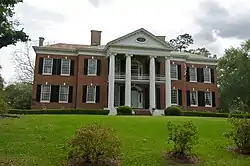Auburn (Natchez, Mississippi)
Auburn is an antebellum mansion in Duncan Park in Natchez, Mississippi. It was designed and constructed by Levi Weeks in 1812, and was the first building to exhibit Greek Revival order in the town.[4] Its prominent two-story Greek portico served as a model for the subsequent architectural development of local mansions. It was declared a National Historic Landmark in 1974[2][5] and a Mississippi Landmark in 1984.[3]
Auburn | |
Mississippi Landmark
| |
 Auburn mansion in April 2011 | |
  | |
| Location | Duncan Park, Natchez, Mississippi |
|---|---|
| Coordinates | 31.54565°N 91.390733°W |
| Area | 4.2 acres (1.7 ha) |
| Built | 1812 |
| Architect | Levi Weeks |
| Architectural style | antebellum Federal style |
| NRHP reference No. | 74001047 |
| USMS No. | 001-NAT-4002-NHL-ML |
| Significant dates | |
| Added to NRHP | May 30, 1974[1] |
| Designated NHL | May 30, 1974[2] |
| Designated USMS | January 5, 1984[3] |
Description
Auburn is a two-story brick building, with a central core and flanking symmetrical wings. A four-column temple front adorns the center of the block, with modified Ionic columns supporting an entablature and fully pedimented gable. The gable has modillioned cornices and an oval window at its center. The main entrance is set in a segmented-arch opening along with flanking sidelight windows and a transom window above. Sheltered by the temple portico is a second floor balcony, which is accessed via a doorway that is only slightly less elaborate than the main entry.[5]
History
In 1811, Lyman Harding, the first Attorney General of Mississippi, hired Levi Weeks, a young architect, to design and build the mansion. The original building was 60 feet (18 m) by 45 feet (14 m) with a two-story portico supported by four columns and includes an unusual floating spiral staircase between the first and second floors.[4] Levi Weeks designed the house to be, in his words, the "most magnificent building in the state."[5]
After Harding died in 1820, the building was bought by Dr. Stephen Duncan, who expanded the house to include two symmetrical wings, greatly expanding interior space. Duncan later abandoned the building amidst growing secession tensions just before the American Civil War, and the house was placed in the care of his descendants.
The building and 222 acres (90 ha) was sold by the family to the city of Natchez in 1911 and is now a historic house museum in a public park.[4][5] The grounds were converted by the City of Natchez into Duncan Park. [6]
.jpg.webp)
See also
References
- "National Register Information System". National Register of Historic Places. National Park Service. January 23, 2007.
- "Auburn". National Historic Landmark summary listing. National Park Service. Archived from the original on 2011-06-06. Retrieved 2007-10-18.
- "Mississippi Landmarks" (PDF). Mississippi Department of Archives and History. May 2008. Archived from the original (PDF) on October 9, 2010. Retrieved April 20, 2009.
- "Auburn Museum and Historic Home". Retrieved April 21, 2009.
- Paul Goeldner (n.d.). "National Register of Historic Places Inventory-Nomination: Auburn" (pdf). National Park Service. Cite journal requires
|journal=(help) and Accompanying 2 photos, 1 exterior and 1 interior, from 1973. (507 KB) - https://books.google.com/books?id=6xVop5rN_aYC&pg=PA252&dq=auburn+natchez+stephen+duncan&hl=en&sa=X&ved=0ahUKEwiAiaf80oHoAhXGU80KHZFCCEsQ6AEITDAF#v=onepage&q=auburn%20natchez%20stephen%20duncan&f=false
External links
| Wikimedia Commons has media related to Auburn (Natchez, Mississippi). |